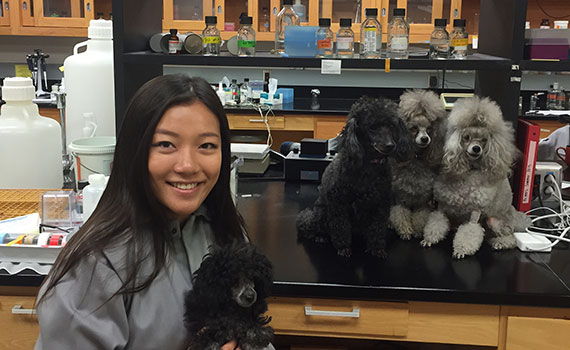Editor’s note: In this series, Colgate students share stories about their summer experiences in offices, labs, and open spaces across the world.
This summer, I am on campus working with Professor Barbara Hoopes in the biology department. Our lab is conducting research on genes that determine size variation in poodles.
Poodles can range in size from 8 inches to more than 26 inches at the shoulder. They are divided by height into standard poodles, miniature poodles, and toy poodles. This research on dog body size can help us understand differences in growth and development in humans, who are much more complex at the genetic level, making them harder to study.
Our goal in the lab is to try to identify novel genes on which genetic variants are likely to cause the size variation in poodles. We use bioinformatics tools like Genome Browser to select for candidate genes (genes that are potentially involved in growth and development). We collect DNA samples from multiple poodles and run a series of experiments to sequence the DNA, and then we analyze the sequences and look for genetic variants.
So far, our lab has identified three variants on one gene and two on another gene. Now we are examining more dogs to confirm their association with size differences. We are also working on new candidate genes, hoping to find more sequence variations.
Professor Hoopes collects most of the dog DNA as cheek swabs from other poodle owners. Last week my lab partners (Melissa Peace ’16 and Erin Huiting ’17) and I went with Professor Hoopes to the Syracuse Obedience Training Club for a dog agility show to collect samples. We met with the owners of poodles whose DNA we frequently use in lab. The show really opened my eyes to how much dogs differ in size and behavior.
Throughout the summer, I have gained a better understanding of dog genetics and bioinformatics tools. More importantly, I’ve learned that every step of a scientific research requires planning, coordination, and collaboration.
My summer lab has prepared me to further explore genetics, because all of the techniques we have used are also used to study human diseases. In the future, I hope to go to medical school and I am really interested in continuing to study genetic disorders.

